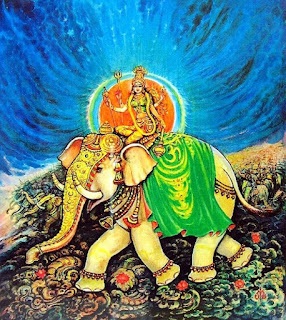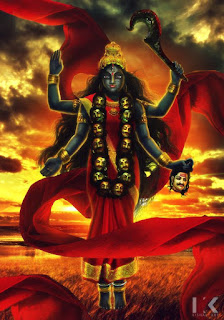The demon Bhandasura
देवर्षि-गण-संघात-स्तूयमानात्म-वैभवा (64)
Devarṣi-gaṇa- saṃghāta -stūyamānātma-vaibhavā
Deva + rṣi + gaṇa. Deva means gods and goddesses, rṣi means sage and gaṇa means demigods. She is worshipped by gods, goddesses, sages, demigods and goddesses. Stūyamānātma means worshipping. Vaibhavā means all pervading. Only Brahman or Pramātman is all pervading.
भण्डासुर-वधोद्युक्त-शक्ति-सेना-समन्विता (65)
Bhaṇḍāsura-vadhodyukta-śakti-senā-samanvitā
She is ready with Her army to wage a war against Bhaṇḍāsura. Her army consists of various goddesses mentioned in Śrī Cakra. The secretive meaning of this nāma is – Lalitai is ready to give us liberation from the cycles of birth and death, provided we have inclination to know about Her. Bhaṇḍāsura is an embodiment of ignorance and resultant evil acts. She is ready to wage a war against ignorance and its associated acts.
सम्पत्करी-समारूढ-सिन्धुर-व्रज-सेविता (66)
Sampatkarī-samārūḍha-sindhura-vraja-sevitā
She is worshipped by herds of elephants headed by Sampatkarī. Sampatkarī Devi has already been discussed in nāma 9. There is also a mention about Sampatkarī Vidyā, which is considered as very powerful.
अश्वारूढाधिष्ठिताश्व-कोटिकोटिभि:-आवृता (67)
Āśvārūḍhā-dhiṣṭhitāśva-koṭikoṭibhi-rāvṛtā
Lalitai is surrounded my many horses headed by Aśvārūḍhā Devi. The left lower arm of Lalithambika is represented by Aśvārūḍhā Devi. She is the chief of the horses used in the war. The face of this Devi also looks like a horse.
चक्रराज-रथारूढ-सर्वायुध-परिष्कृता (68)
Cakrarāja-rathārūḍha-sarvāyudha-pariṣkṛtā
Cakrarāja is the chariot of Lalitāmbikā in which She travels along with all types of weapons. Weapons mean the ways of attaining suddhavidyā or pure knowledge which is called the knowledge of the Brahman. This chariot consists of nine tiers. This Cakrarāja is said to mean the Śrī Cakra, the place of Lalitāmbikā. Pariṣkṛtā means adorned.
गेयचक्र-रथारूढ-मन्त्रिणी-परिसेविता (69)
Geyacakra-rathārūḍha-mantriṇī-parisevitā
Two chariots always accompany the Cakrarāja chariot. Out of the two, the first one is being discussed here, which is called Geyacakra chariot. This is the chariot of Mantrinī Devi who is also called Śyamalā Devi.
किरिचक्र-रथारूढ-दण्ड-नाथा-पुरस्कृता (70)
Kiricakra-rathārūḍha-daṇḍa-nāthā-puraskṛtā
Kiricakra ratha is the chariot of Daṇḍanāthā Devi who is also called Vārāhī Devi. This Devi is considered as very powerful. Kiri means Vārāha. Vārāha means boar (pig). Her face is like a pig. Her chariot is also in the shape of a pig. She is called Daṇḍanāthā because she always carries a daṇḍa (staff) with her. Kiri means rays of light and light here means creation.
Vārāhī is the chief of Her army. Vārāhī has the capacity to drive away the evil forces. If Vārāhī is worshiped on the 18th day of the month of āṣāḍha (July-August), it's believed that she showers prospers on the worshipper.
ज्वालामालिनिकाक्षिप्त-वह्निप्राकार-मध्यगा (71)
Jvālāmālinikākṣipta-vahniprākāra-madhyagā
Jvalāmālini, one of the tithi nityā Devi-s constructed a fortress of fire during the war with Bandasura and Lalitai resides in the midst of this fortress. Tithi Nityā Devi-s are the goddesses of each lunar day. Jvālāmālini is the goddess of fourteenth tithi, called caturdaśi. Lalitāmbikā is called mahā nityā representing both full moon and the new moon (16th day).
भण्डसैन्य-वधोध्युक्त-शक्तिविक्रम-हर्षिता (72)
Bhaṇḍasainya-vadhodhyukta-śakthivikrama-harṣitā
When Her śaktī-s (army) destroy the army of the demon Bhaṇḍasurā, She is delighted.
Bhaṇḍa also means ignorant soul afflicted with duality, sainya (army) vadha means destruction. Lalitai is delighted when one destroys duality. When duality is removed, it is an indication of the removal of the veil of māyā.
नित्या-पराक्रमाटोप-निरीक्षण-समुत्सुका (73)
Nityā-pārākramāṭopa-nirīkṣaṇa-samutsukā
Nitya means tithi nitya devi-s. Lalitai is happy on observing the valour of these fifteen tithi nityā devi-s during the war.
भण्डपुत्र-वधोद्युक्त-बाला-विक्रम-नन्दिता (74)
Bhaṇḍaputra-vadhodyukta-bālā-vikrama-nanditā
Bālā is daughter of Lalitai and is nine years old. Bhandāsura had thirty sons. In spite of Lalitai advising Her daughter not to go to the battle field, Bālā prevails upon her mother and wages a war against all the thirty sons of Bhandāsura and destroys them.
मन्त्रिण्यम्बा-विरचित-विशङ्गवध-तोषिता (75)
Mantriṇyambā-viracita-viśaṅgavadha-toṣitā
She is delighted with the destruction of demon Viśaṅgavadha by Mantrinī (ṣyamalā) Devi. Viśaṅga and Viśukra are the two brothers of Bhandāsura. There were created by Bhandāsura from his shoulders.
विशुक्र-प्राणहरण-वाराही-वीर्य-नन्दिता (76)
Viśukra-prāṇaharaṇa-Vārāhī-vīrya-nanditā
Viśukra is the brother of Bhandāsurā. Vārāhī Devi slays Viśukra and Lalitai is happy with the bravery of Vārāhī Devi. Vārāhī is supposed to be the most powerful of the three Devi-s, Bala, Mantrini and Varahi. She cannot tolerate any indiscipline.
कामेश्वर-मुखालोक-कल्पित-श्रीगणेश्वरा (77)
Kāmeśvara-mukhāloka-kalpita-śrīgaṇeśvarā
Gaṇeśhā was born out of a mere glance of Lalitai at Kāmeśvara. Gaṇeśhā is the first son of Śiva and Pārvathī. Bhandāsura during the war witnesses the destruction of his army. In order to avoid further causalities to his army he orders a yantra by name jaya vignaṁ to be kept in the midst of the army of Lalitai.
महागणेश-निर्भिन्न-विघ्नयन्त्र-प्रहर्षिता (78)
Mahāgaṇeśa-nirbhinna-vighnayantrā-praharṣitā
Gaṇeśa was created to remove the yantra, jaya vignaṁ planted by Bhandāsurā. Gaṇeśā removes that yantra and helps the army of Lalitai to regain their self confidence. Lalitai is delighted with Gaṇeśa, when he removes the yantra.
भण्डासुरेन्द्र-निर्मुक्त-शस्त्र-प्रत्यस्त्र-वर्षिणी (79)
Bhaṇḍāsurendra-nirmukta-śastra-pratyastra-varṣiṇī
She counters the weapons used by Bhandāsura, by using Her own. Here, two types of weaponaries are mentioned. One is astra that is thrown at the enemies in a battle field. Modern day bombs can be compared to this. Another is śastra, which is always held in hand, like a gun. The weaponaries of Lalitai aids our efforts in attaining bliss by destroying avidyā. Weapons coming out of Her hands are aimed at us in destroying the illusion of duality.
कराङ्गुलि-नखोत्पन्न-नारायण-दशाकृतिः (80)
Karāṅguli-nakhotpanna-nārāyaṇa-daśākṛitiḥ
She created ten incarnations (dasa-avatāra) of Śrī Nārāyaṇa from Her nails. Bhandāsura created ten demons like Rāvana and others from his missile Sarvāsurāstra. These ten demons were killed by Lord Mahā Viṣṇu during His ten incarnations. Nārāyaṇa means jīva and Īśvara.
महा-पाशुपतास्त्राग्नि-निर्दग्धासुर-सैनिका (81)
Mahā-pāśupatāstrāgni-nirdagdhāsura-sainikā
She burns the army of the demons with the astra called mahā-pāśupatā. This astra produces fire that causes the destruction of the entire enemy camp.
कामेश्वरास्त्र-निर्दग्ध-सभण्डासुर-शून्यका (82)
Kāmeśvarāstra-nirdagdha-sabhaṇḍāsura-śūnyakā
Śūnyaka is the capital of Bhandāsura. Bhandāsura is burnt along with his capital city by the fire from astrā of Kāmeśvara.
With this nāma the war with Bhandāsura ends with the killing of Bhandāsura and his warriors along with the destruction of his kingdom.
ब्रह्मोपेन्द्र-महेन्द्रादि-देवसंस्तुत-वैभवा (83)
Brahamopendra-mahendrādi-devasaṃstuta-vaibhavā
The victorious Lalithai is celebrated and worshipped as the supreme and omnipresent power by Gods like Brahma, Vishnu and Shiva.
हरनेत्राग्नि-सन्दग्ध-कामसंजीवनौषधीः (84)
Haranetrāgni-sandagdha-kāmasaṃjīvanauṣadhīḥ
Manmatha, the god of love is burnt by the third eye of Śiva. Śaktī resurrects Manmatha. Sañjīvana is a herbal medicine that causes resurrection. Therefore She is praised as sañjīvana for Manmatha. The motherly nature of Lalitai is highlighted here.





















No comments:
Post a Comment